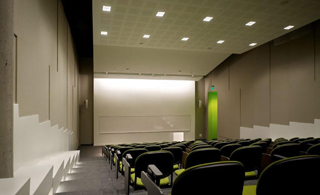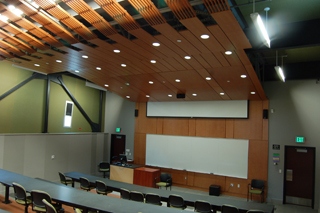
DJC.COM
August 20, 2009
Bouncing sounds make lecture halls tricky to design
Sparling

Jurdy
|
In the sixth century B.C., Pythagoras of Samos related the vibrations of strings from a stringed instrument to the pitch and intensity of the sounds emanating from them. Over time, scientists discovered that air is needed to make sound and, ultimately, that sound moves as waves through the air.
Acoustical designers are intimately familiar with the fundamentals of sound, allowing them to design for optimal acoustical environments in a variety of interior spaces — one of the more challenging being the lecture auditorium.
Many factors affect the way sound travels in a room and how we hear it. In any room, the speech that is heard is a combination of the direct sound that travels straight from the speaker to the listener, and the reflected sound that bounces off, or is absorbed by, the walls, floor, ceiling or furniture before it reaches the listener.

Photo by Ben Benschneider, Courtesy of Snap-Tex Parallel walls can generate rapid echoes. Sound-absorbing panels, such as these at the University of Washington School of Medicine, can dampen them. |
In a lecture auditorium, clarity of the spoken word is critical. The design of these spaces requires a balance of geometrical surfaces, composite partitions and building systems that enhance speech intelligibility for the audience.
Room design
Room volume: Volume is typically governed by the height of the ceiling, driven by the logistics of a person standing in the front of the room with a video screen behind or to the side. It is not necessary to create volume simply for the sake of the acoustics in a lecture hall.
Orientation of walls: Parallel walls can create what is called a “flutter echo” which is composed of multiple echoes occurring in rapid succession.
A fan-shaped room creates a more intimate room that physically moves the audience closer to the speaker. Since the audience is closer, the natural sound from the speaker is louder.
If a more rectilinear space is preferred, the front walls should ideally angle out from the speaker by roughly 7 percent each to avoid a flutter echo. As an alternative to splaying the front walls, they can be covered with an acoustically absorptive material to avoid flutter echo.
Video screens: Lecture hall video screens have a 16:9 or 16:10 aspect ratio, in keeping with HDTV or widescreen computer formats, respectively.
The minimum height of the screen should be one-sixth the distance from the screen to the farthest viewer. The closet row of seats should be twice the height of the screen away, and the top of the screen should be no more than 35 degrees from the viewer’s horizontal line.
Designing for sound

Photo by Basel Jurdy No microphone? The sound-reflective ceiling over the lectern at Peninsula College in Port Angeles is tilted toward the audience to amplify speech. |
The acoustical room response for a lecture hall should be dampened.
The technical term to describe room response is reverberation time (RT), which is the amount of time (in seconds) for sound to decay 60 decibels after the source of sound has ceased. RT was developed in 1898 by Wallace Clement Sabine, a pioneer of architectural acoustics.
Rooms are dampened by adding acoustical absorption to its surfaces.
A unit of acoustical absorption is called a Sabin (named after Sabine), and is equal to 1 square foot of completely absorptive material. Materials typically used in the construction of rooms have different absorption at different sound frequencies (pitch).
Sheetrock, for example, acts like a drum head and absorbs low frequency sounds but does not absorb middle or high frequency sounds well. Acoustical wall panels, fabric over a semi-rigid fiberglass core, are absorptive in the middle and high frequency regions. This is the region most important for speech intelligibility.
People absorb sound, so when the lecture hall is full of people, it will be more acoustically dampened. To make the auditorium less dependent upon people, cushioned seats and backs provide absorption in the audience area regardless of the occupancy.
Most of the ceiling needs to be acoustically absorptive. Acoustic tile, perforated wood or metal, or acoustical plaster are common treatments for ceilings.
To use the room without electronic amplification, a hard sound-reflective portion of the ceiling can be inserted above and slightly forward from the lectern to act as a sounding board for natural speech. Positioning the leading edge (toward the audience) of this portion of the ceiling slightly higher than the trailing edge will reflect sound back toward the rear portion of the audience, which needs the extra sound.
The ear integrates direct sound from the speaker with reflections that arrive within the first 50 milliseconds. Sound arriving within this window contributes to the intelligibility of speech. Sounds arriving at a listener location after this window degrade speech perception.
With respect to room design, this means is that reflections off of the front half of the ceiling and side walls is generally beneficial to speech perception, and sound reflecting from the rear of the room is detrimental to speech intelligibility.
Absorptive materials such as acoustical wall panels should cover most of the rear wall of the auditorium and a portion of both side walls. If the rear wall has a control room window, the height of the window should be kept to a minimum to avoid unwanted reflections from the electronic speakers.
Outside noises
Unless auditorium is located is a very quiet area, it is unlikely that natural ventilation can be used. Noise intruding through the windows would interfere with speech intelligibility.
Noise is produced by the heating and ventilating system. It can result from radiation off the equipment itself (airborne), through connections between the equipment and the structure (structure borne), and from radiation down ductwork connected to fans (duct borne).
Design criteria for HVAC-system noise is referred to as noise criteria (NC) curves, or some variation thereof. They are defined by the American Society of Heating, Ventilating and Air Conditioning Engineers.
The latest ASHRAE guide suggests design criteria of NC 25 to 30 in large lecture halls with amplification, and less than NC 25 without amplification. NC 25 would be considered a very quiet system, although still audible when the room is quiet. Designers should select the quietest equipment the budget will allow.
It is preferred that HVAC equipment is located away from the lecture hall and not on the roof over the hall or in rooms immediately adjacent, otherwise equipment needs to be mounted on vibration isolators to avoid direct contact with the structure.
HVAC supply and return ductwork also allows noise into the hall to interfere with the acoustics. Pre-manufactured elements that replace a short section of duct called duct silencers should be used in lecture halls. Alternatively, if the equipment is located a considerable distance from the hall and if acoustical duct lining is allowed in the facility, sections of the ducts can be lined with duct lining.
Front-row sound
To reach optimal functionality, lecture halls should be designed to direct sound from the speaker to the listeners by shaping to eliminate unwanted echoes and quieting to maintain clarity of the spoken word. Distorted and muffled sound in lecture halls caused by flutter echoes, inaccurate room response and/or HVAC noise can distract the audience, or worse, can cause some to barely hear the speaker from their seats at all.
For this reason, the lessons learned over the centuries from Pythagoras to Sabine to today’s acoustical designers are invaluable. The science of sound has led to techniques and technologies that create an acoustical lecture environment where crisp and intelligible sound throughout the room makes each seat a front row seat.
Basel Jurdy is a principal at Sparling, an acoustical, audiovisual, electrical and technology design firm with offices in Seattle, Portland and San Diego. He can be reached at bjurdy@sparling.com.
Other Stories:
- My epiphany on learning: It’s the method, not the content
- South Shore campus will create a hub for the community
- Medina school celebrates cycles of nature, learning
- Architects add a new role to their job duties: facilitator
- Attention to detail makes WWU building unique
- 7 things you need to know to build a better stage
- Robert Frost Elementary design takes road less traveled
Copyright ©2009 Seattle Daily Journal and DJC.COM.
Comments? Questions? Contact us.